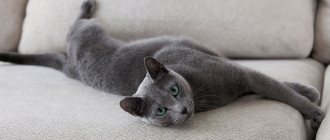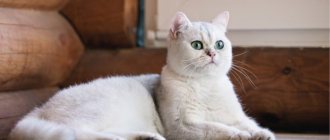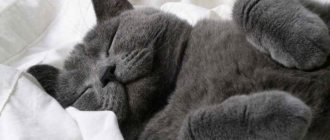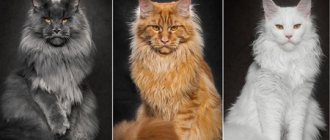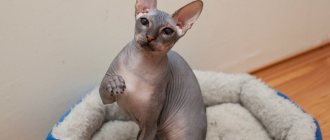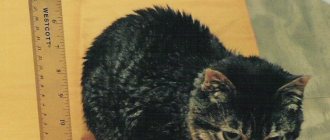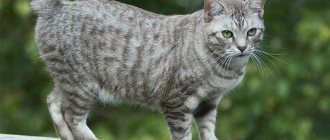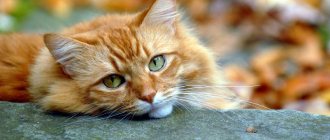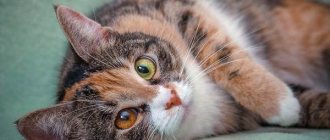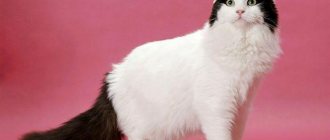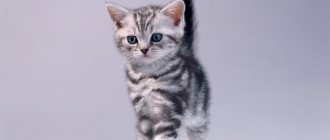Why do you need brushes?
Scientists have several versions regarding the tassels on the ears. Each of them has its own pros and cons. But the most likely are the following:
- The hard tufts of hair at the tips of the ears are analogous to an antenna and help amplify even the quietest sounds. It is not for nothing that the ancient Slavs revered the lynx because of its keen vision and very sensitive hearing. It was believed that the animal was able to hear the hunter’s steps several kilometers away and hide in time. An experiment was conducted that proved that when the tassels are removed, animals hear worse.
- Tassels are a kind of marker of the animal’s maturity. In an adult cat they are longer and darker. When a couple meets, the female can choose a more experienced, mature male, which increases the viability of the offspring.
- Tassels are beacons. Lynx is not only an excellent hunter. This beast is a master at hiding. It is believed that seeing a lynx is a sign of great luck. Tassels, visible to other animals and the cat’s relatives, will not allow you to invade its territory, and during the rut, it will not allow you to find a partner in the thicket.
It is obvious that wild cats need tassels for some reason, since centuries-old selection has preserved this trait to this day.
Many breeds have tassels. Kittens have them, but with age they hide in the pubescence of the ears or disappear completely. But there are 6 cat breeds for which ear tufts are a breed characteristic that persists throughout life.
Popular breeds
Among the most popular cat breeds with ear tufts, we highlight:
Maine Coon
This breed was first presented at an exhibition in Boston in 1861. The cat was distinguished by its unpretentious and calm character, as well as outstanding hunting qualities, thanks to which it settled on North American farms for a long time.
The owner of the Maine farm, Linda Choate, bred numerous offspring from two cats. Thanks to her, the new breed became known as the Maine Coon.
Maine Coons are distinguished by short, dense hair on the head, thick undercoat, wide paws and very long whiskers, which prevent them from bumping into branches in the dark.
IMPORTANT: there are several legends, in the first the Maine Coon is the result of crossing a lynx and a domestic cat, and the second believes that the stripe on the back indicates the crossing of indigenous breeds with a raccoon. The species differences of these animals deny such mixing.
Despite its harsh external appearance, the Maine Coon is a surprisingly intelligent, peaceful and domestic cat. Perhaps this is precisely what causes admiration for this breed: despite its wild appearance, the animal has a good nature that allows it to be strong friends with people and other domestic animals.
IMPORTANT: the largest Maine Coon is included in the Guinness Book of Records and weighs 16 kg.
Pixie Bob
Cats of this breed are very reminiscent of the North American lynx, and among breeders and breeders these pets are called “elves.”
The appearance of these cats is distinguished by a large body and paws, a well-developed muscular structure, the coat can be either long-haired or short-haired. The spotted color of the cat is a sandy or smoky tabby with uniform patches of dark color.
People call these cats “short-tailed elves”
Pixie-Bob has a wild and deep look, but despite this, the “elf” is a very friendly and patient pet who will willingly get along with children and other animals. With such an animal you will always be active: the breed requires the implementation of the hunter's instinct, as well as regular games in nature. Many owners note that Pixie-Bob often behaves like a very smart dog.
Norwegian Forest Cat
About 4-5 centuries ago, in the forests of Norway, wild native cats crossed with Angora cats, resulting in the appearance of the Norwegian forest cat.
This extraordinary breed has inherited the best qualities from its ancestors, and survival in harsh northern conditions has left its mark. The cat has long and thick hair, which will allow it to survive a very frosty winter. The peculiarity of wool is that it does not allow moisture to pass through and does not get wet when the cat moves through the snow.
The Norwegian Forest Cat is a true northerner
IMPORTANT: in Scandinavian mythology, Norwegian forest cats accompanied Thor himself, and during the Second World War the breed almost disappeared, but the Norwegian government made great efforts to restore the population.
Like previous breeds, the Norwegian Forest stands out for its large body and well-developed muscles. The ears are set wide apart, with small dense tufts of black hair at the tips. The cat has a very active, lively and peaceful character, thanks to which the fluffy northerner will become a faithful friend to his owner.
Caracal
The caracal is a steppe lynx that lives in wild fauna. To get a friendly and loyal friend, you need to raise the animal as a kitten. This is an extraordinary pet that has been identified as a separate species.
In the photo there is a caracal kitten, which at an early age resembles a baby puma or lynx
The animal resembles a lynx, but is closer in origin to a puma. The breed has a strong structure, well-developed muscles, a short tail and close-lying hair. The color of the animal's fur coat is usually uniform, red-brown with lighter coloring along the belly and tail.
Caracal has amazing and wild beauty
IMPORTANT: in Russia and especially in the CIS, caracal is a rarity. You can meet such a cat near the mountains and deserts of Dagestan.
The caracal is very hardy and peaceful, but the most important condition for this is the proper upbringing of the animal.
Siberian
The history of the breed begins in the 15th century and, according to one version, the Siberian, Persian and Angora breeds have one common ancestor. However, the Siberian cat was identified as a separate species, having gone through the harsh trials of the Urals and Siberia.
Like the Norwegian Forest Cat, the Siberian breed is very resistant to frost and wind; their coat has a thick double undercoat and is highly waterproof. This is a strong, robust and resilient cat, which has a very devoted character: it will patiently follow its owner, without requiring constant affection and increased attention. The breed has a highly developed hunting instinct; in a dangerous fight, a Siberian can defeat even a rat.
The hardy and reserved Siberian cat is very similar to its Norwegian “sister”
IMPORTANT: adult Siberian cats love to sit and lie on high places in the house, thus protecting the territory.
Siberian cat
The cat with tufted ears shown in the photo above is a representative of the Siberian breed. The Siberian forest cat is a natural species of wild cat that has lived in Russia since ancient times. The exact origin of the animal is unknown, but its homeland is considered to be the Trans-Urals.
The breed received official status relatively recently - in the late 1980s. During this period, its active selection began to obtain a variety of colors. In 1990, the Siberian visited exhibitions in the USA for the first time. But, despite the popularity it has gained, it can rarely be found outside of Europe. This is due to the bureaucratic difficulties of transporting an animal.
The Siberian cat has long, thick hair with soft down. The special structure of the fur coat makes it waterproof. Despite the increased fluffiness, you should not brush the coat too often. It is enough to comb 2-3 times a month. During the molting period, the procedure will need to be repeated more often: 2-3 times a week.
Siberians are considered hypoallergenic animals. They produce low levels of the protein Fel d 1, which is secreted by the salivary and sebaceous glands of cats. The research was conducted by several non-profit organizations. The results showed that Siberians have a lower Fel d 1 content compared to other breeds. Therefore, the risk of developing allergies to these animals is reduced.
Important! Despite their hypoallergenic characteristics, Siberian cats, like other cats and dogs, can cause an allergic reaction in humans. Therefore, if you have a severe allergy to animals, you should consult an allergist before getting a pet.
Siberians are very active. They still have hunting instincts from their ancestors. They can hunt mice and even catch rabbits. Their hind legs are slightly longer than their front legs, which makes them incredibly jumping and agile.
Pets get along well with humans and are not afraid of strangers. However, their respect must be earned. Siberians are not characterized by excessive affection and complaisance. They are independent and willful. In addition, Siberians are distinguished by their longevity: the average life expectancy is 15-20 years.
Wild cats with tassels on their ears
When mentioning the tassels on a cat's ears, the first thing many will think of is the lynx - this is a famous representative of the cat family.
The lynx has developed muscles and a strong body - without this it is impossible to survive in the wild. The northern cat, with its independent disposition, is small in size and chooses deep forests and taiga as its home. These cats are very active, they swim well, climb trees a lot and generally lead a sedentary lifestyle. Lynxes hunt at night and feed on hares, small ungulates and small rodents; occasionally a lynx can attack a wild dog or raccoon.
Lynx has several subspecies: common, Canadian, Pyrenean and red.
The Caracat is another breed that is considered rare and is the result of a cross between the Caracal and the Bengal cat. In the nursery of Irina Nazarova, from 2013 to 2021, 2 individuals of these cats were bred.
Caracat is a new breed of cat that has not yet become widespread
This breed has a strong body, a smoky or sand-colored coat, and a large size (an adult cat can weigh 15 kg). This is an energetic, intelligent and balanced hunter who can become an excellent companion. Keeping such an animal requires a large area and special conditions: the cat will eat only natural food.
At the moment, this breed is not in demand, as it was bred quite recently and has a high cost.
Maine Coon: “Don’t believe your eyes”
This list opens with the American aboriginal breed Maine Coon, and not by chance. Today it is experiencing a surge in popularity and, according to some experts, it is in third place in terms of distribution after the Persian and exotic cats, despite the fact that it is considered an expensive breed (Maine Coon kittens can cost from 600 to 1500 dollars). This cat is notable for many qualities and is considered one of the largest breeds. The weight of an adult cat can range from 4.5 to 6 kg, and that of a male cat - from 7 to 12 kg. Most often, this is what they mean when talking about a cat with ear tufts.
Its unusual appearance, reminiscent of a raccoon, at one time gave rise to a number of versions regarding the origin of this breed. Their diversity, testifying to the rich human imagination, is truly amazing. The birth of this breed is associated with raccoons, lynxes, wild cats, and Norwegian cats, which were brought to North America by the Vikings, and with Turkish Angora cats that belonged to the French queen Marie Antoinette, and with the cats of the English navigator, explorer of the East American coast Charles Kuhn... However, these versions are destined to remain myths and legends surrounding this wonderful breed. The only thing that can be said more or less accurately is this: humanity first discovered this breed in Maine around the middle of the 19th century. Everything else - even plausible information about traders from Asia Minor who brought long-haired cats with them to America, which became the possible ancestors of the Maine Coon - is nothing more than versions with varying degrees of probability and reliability.
However, this breed is loved and appreciated not at all because of the abundance of theories of origin that surround it - rather, their number is a consequence and indicator of the popularity of Maine Coons in the world. It is enough to look at least at this photo to succumb to the charm emanating from this creature.
Maine Coon
True, a visual image conveys only the appearance of the animal, but this shortcoming can be easily corrected thanks to a verbal story. In the case of Maine Coons, the saying “looks can be deceiving” is quite true. Despite their strict appearance, cats of this breed:
- unusually affectionate, friendly and peaceful.
- They are affectionate to the owner, prefer to constantly be near him, while showing unobtrusiveness and delicacy.
- are independent and independent, so if you decide to have such a cat at home, you will need to provide her with a personal space in the form of a house so that she can be alone there if she wants.
- They are active and mobile even in old age, they love dynamic games, which they can indulge in both with people and alone.
- clean and tidy.
- They have good intelligence and memory, perfectly remember intonations and words, subtly sense the mood of their household (especially their owner) and understand them almost at first sight.
- They can get along with almost any pet.
- excellent hunters of mice and rats.
- wonderful nannies for small children.
- easily adapt to a new habitat.
- easy to care for and maintain. Some attention should be paid only to the coat: comb it once a week, and during the annual molting period - every day.
Agree, after all of the above, it is difficult not to fall in love with such a cat, which also has an extremely pleasant melodic voice with many different semantic intonations. Surprisingly, but true: it has been noticed that each cat of this breed has only its own, unique timbre of voice. Its varied color is also noteworthy.
Chauzie
The breed is the result of crossing an ordinary cat and a jungle cat.
Character
Shawzis are lovers of active games. They cannot stand loneliness. They willingly participate in all the affairs of family members. They are strong friends with children and can play with them for hours. Very curious and can leave the house through the window, you should be more attentive to her.
Breed characteristics and care
Chausie has short hair and a thick undercoat; The color of the animal can be silver, gold, black. Shausi's physique is strong, his muscles are well developed, his limbs are long, his paws are of medium size; The ears are large. Closer to the base they are wide, the edges are narrowed with tassels; The eyes are slanted. Specimens with light green and amber eyes can be registered in the breed; This breed only needs to be brushed during the shedding period.

